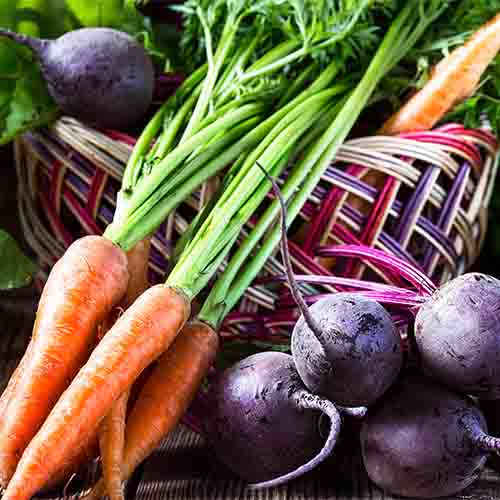Garden Vegetables & Herb Plants
Get into edible gardening & taste the difference! Grow your own tomatoes, cucumbers, peppers, lettuce and herbs.
A great project for the entire family, starting an edible garden is a rewarding activity that will provide you with fresh delicious food to enjoy from spring to fall. Skip the grocery store and enjoy your own harvest. Nothing is more rewarding or tastes better! Below are some tips on how you can easily grow your own vegetables and herb garden. For fruit trees and shrubs CLICK HERE



Garden Dreams Begin with Seeds
Get a head start by grabbing essential seed starting supplies now. We carry over 600 varieties of heirloom, organic and GMO free seeds (available February).
From seeds to soil, grow lights to plant labels, we have everything you need to succeed. Available in-store or online.



We Have the Largest Selection of Vegetable and Herb Plants
-
90 plus varieties of cool weather vegetables and fruit plants (available March-May)
-
More than 50 varieties of tomato plants (available late April early May)
-
Over 40 varieties of pepper plants (available late April early May)
-
More than 100 varieties of USDA organic vegetable plants (available late April early May)
-
Freshly grown organic fall vegetable plants (beginning mid August)
Vegetable and Herb Plants for Sale In-Store Only.
Vegetable gardening should not be overlooked in early spring. That’s the time to decide where the garden will go and how much space you have available. So many of us wait until after we’ve already purchased the plants to decide where the garden should go and that is when we discover we have purchased too many plants!
Take the time to prepare your garden before you plant. Then by following through on watering, pruning and fertilizing the rest of the season, you will ensure your garden is lush and fruitful.
If you’re starting with seeds, you can start seeds for tomatoes, peppers and other warm-weather vegetables indoors in March.
When to Plant Outside
Cool weather crops: Early April
- lettuce
- onions
- carrots
- kale
- beets
- radishes
- spinach
- parsley
- rosemary
These plants perform best in daytime temperatures around 60-65 degrees Fahrenheit and tolerate some light frost. They are harvested in late June through July before the heat of summer.
Warm weather crops: After May 15th
- tomatoes
- peppers
- cucumbers
- eggplants
- melons
- zucchini
- basil
- herbs (annuals)
Check the forecast to make sure threat of frost has passed as these plants require higher soil and air temperatures. They have one growing cycle ranging from late spring to late summer.
Plant a Second Crop mid-late August
Have you ever wondered why farm stands have such great produce in the fall? It is because they plant a second crop around mid to late August.
- Warm summer temperatures help a plant establish its root system
- Cool fall weather encourages bountiful yields
Many vegetables, including lettuce and broccoli, can be harvested until the ground freezes.
We carry freshly grown organic vegetables and herbs to plant in the fall including:
Basil, Beets, Broccoli, Cauliflower, Carrots, Cabbage, Kale, Lavender, Lettuce, Mint, Oregano, Peas, Parsley, Rosemary, Squash, and Thyme.



Tips for a Successful Vegetable & Herb Garden
Where to plant vegetable & herb plants:
Vegetable & herb gardens should be located in full sun; avoid areas that are shaded by trees, buildings or other structures. The soil should drain well and not puddle for any length of time. An indoor herb garden can be grown all year long for easy access to fresh herbs in the colder months.
Prepping the soil:
Good soil preparation before planting will guarantee healthy herb and vegetable plants and higher yields at harvest time. Mix in a soil amendment with a high organic content such as Dr. Earth Vegetable Garden Planting Mix or compost into the soil. Rake the area smooth and level, breaking up clods and lumps of soil.
Planting vegetables & herbs:
It is very important to follow the spacing guidelines on the seed pack or plant label for each type of vegetable or herb. This ensures your plants have the room they need to grow and produce fruit. Plants like tomatoes, peppers, basil and eggplant may require the extra support of a tomato cage or stakes.
Fertilizer:
Remember, you are what you eat, so choosing an organic fertilizer for your vegetable & herb garden is a must. Apply once a month May through August for optimum results.
Watering:
Water vegetable & herb gardens only when the soil is dry and needs it. Deep, but infrequent, watering, two or three times a week is best if there is no natural rainfall. Excessive watering may encourage insect and disease problems. It is best to keep the leaves of your vegetable and herb plants dry, so water the soil at the base of the plants only.
Get Happy. Get Healthy. Get Gardening.
Did you know that gardening has amazing health benefits?
Gardening has been proven to make people happier, feel great satisfaction and provide self sufficiency. Plus tending to your garden gets you out in the sunshine for much needed natural vitamin D.

Any questions? Let us know. We are here to help you every step of the way!
TOOL
